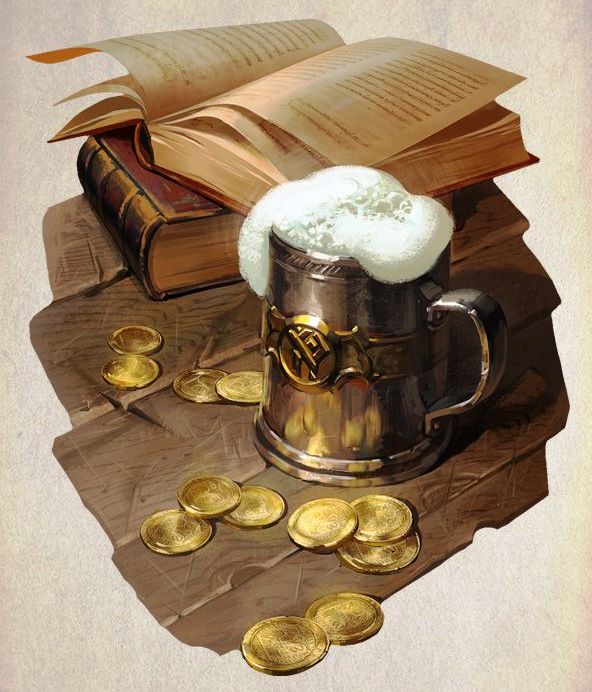Difference between revisions of "Small Beer (drink)"
Tao alexis (talk | contribs) |
Tao alexis (talk | contribs) |
||
| Line 1: | Line 1: | ||
[[File:Small Beer.jpg|right|525px|thumb]] | [[File:Small Beer.jpg|right|525px|thumb]] | ||
| − | '''Small beer''' is a [[Intoxication|low-proof]] beverage made from [[Barley|barley]], | + | '''Small beer''' is a [[Intoxication|low-proof]] beverage made from [[Barley|barley]], traditionally brewed by [[Commoner|farmers]] in rural homes, in [[Bakery|bakeries]], and in smaller quantities within [[Brewery|breweries]]. The term "small" refers to the beer's mild nature and the absence of hops, as farmers were often forced to rely on a "gruit" — a mixture of locally available flower buds and herbs — to flavour their brew. |
| − | Most persons in the western game world | + | Small beer was widely consumed as a safer alternative to well-water, which was often contaminated. The brewing process sterilised the water, ensuring that the resulting beverage was free of harmful bacteria. Beyond safety, it was a vital source of daily sustenance, providing a consistent intake of calories for labourers and isolated farmers. The fermentation process retained essential nutrients from the barley, making it a staple in many diets. |
| + | |||
| + | Most persons in the western game world consume between 8 and 12 ounces of small beer per day, with even children partaking in moderate amounts, as its low alcohol content posed little risk compared to stronger ales. | ||
== Making == | == Making == | ||
| − | While bakeries and brewers | + | While bakeries and brewers cultivate their own yeast, the ordinary farmer relies on wild yeast, harvesting it by leaving a bowl of flour and water exposed to the elements, encouraging the yeast from plants to attach itself. The process of brewing small beer begins with malting barley in warm, damp conditions for about a week, converting the grain’s starch into fermentable sugar. The malted barley is then dried in a bread oven, halting germination while preserving the converted sugars. |
| − | Small beer is typically served in a full stein and costs 2 [[Coin (monetary unit)|c.p.]] | + | Next, the grain is boiled in water to extract the sugars and sterilise the liquid. This crucial step ensures that well or river water—often unsafe on its own—is rendered potable. Once the liquid has cooled, yeast is added to begin fermentation. The low alcohol content of the resulting beer preserves it without making it overly intoxicating. |
| + | |||
| + | Small beer is typically served in a full stein and costs 2 [[Coin (monetary unit)|c.p.]]. Due to its affordability, it remains the most commonly consumed alcoholic beverage among peasants and commoners. | ||
| Line 13: | Line 17: | ||
[[Bakery]]<br> | [[Bakery]]<br> | ||
[[Brewery]]<br> | [[Brewery]]<br> | ||
| − | [[Food |Food]]<br> | + | [[Food|Food]]<br> |
[[Inn]] | [[Inn]] | ||
| + | |||
| + | [[Category: Reviewed]] | ||
Revision as of 23:20, 16 February 2025
Small beer is a low-proof beverage made from barley, traditionally brewed by farmers in rural homes, in bakeries, and in smaller quantities within breweries. The term "small" refers to the beer's mild nature and the absence of hops, as farmers were often forced to rely on a "gruit" — a mixture of locally available flower buds and herbs — to flavour their brew.
Small beer was widely consumed as a safer alternative to well-water, which was often contaminated. The brewing process sterilised the water, ensuring that the resulting beverage was free of harmful bacteria. Beyond safety, it was a vital source of daily sustenance, providing a consistent intake of calories for labourers and isolated farmers. The fermentation process retained essential nutrients from the barley, making it a staple in many diets.
Most persons in the western game world consume between 8 and 12 ounces of small beer per day, with even children partaking in moderate amounts, as its low alcohol content posed little risk compared to stronger ales.
Making
While bakeries and brewers cultivate their own yeast, the ordinary farmer relies on wild yeast, harvesting it by leaving a bowl of flour and water exposed to the elements, encouraging the yeast from plants to attach itself. The process of brewing small beer begins with malting barley in warm, damp conditions for about a week, converting the grain’s starch into fermentable sugar. The malted barley is then dried in a bread oven, halting germination while preserving the converted sugars.
Next, the grain is boiled in water to extract the sugars and sterilise the liquid. This crucial step ensures that well or river water—often unsafe on its own—is rendered potable. Once the liquid has cooled, yeast is added to begin fermentation. The low alcohol content of the resulting beer preserves it without making it overly intoxicating.
Small beer is typically served in a full stein and costs 2 c.p.. Due to its affordability, it remains the most commonly consumed alcoholic beverage among peasants and commoners.
